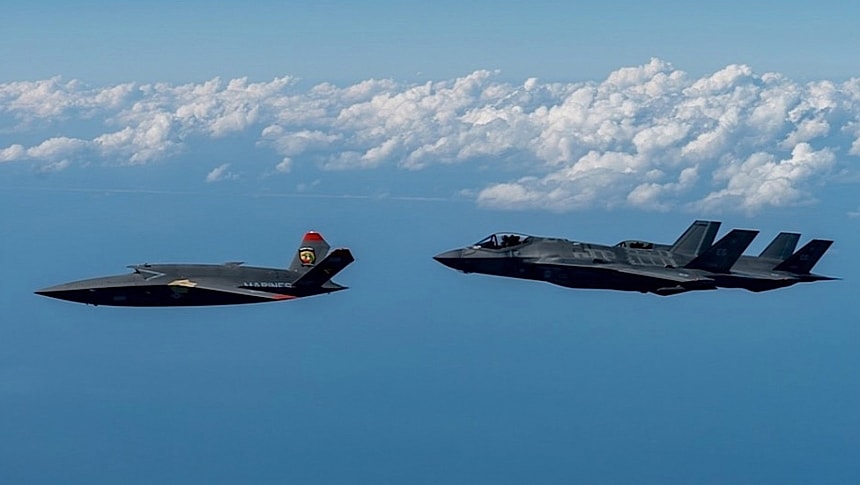There's a good chance that if you blinked these past two years, you missed a couple of very important developments when it comes to military drones: some of these things can now fly themselves, with no need for ground controllers, and on top of that they can conduct missions alongside other aircraft, crewed or otherwise.
It's a sort of natural evolution drone-making companies have rapidly embraced and the military, especially the American one, is actively encouraging.
One of the new-generation drones that is capable of doing both of the things mentioned above is the XQ-58A Valkyrie. Made by a company called Kratos and first flown in 2019, the Valkyrie is slowly honing its skills and learning new tricks to come to the aid of American military aviators.
The latest stunt the drone pulled took place at the Eglin Air Force Base in Florida, during a live flight test. We're not told when the test happened, but we do know, thanks to Kratos, that the Valkyrie was down there to prove one of its most important capabilities: conducting electronic attacks on targets.
The test was the final one in the Penetrating Affordable Autonomous Collaborative Killer – Portfolio (PAACK-P) program run by the U.S. Marine Corps, and comes on the heels of an engineering development and flight test demonstrations contract(worth almost $23 million) awarded to Kratos at the end of last year.
For the drone to prove itself it had to fly alongside a couple of F-35 fighter planes flown by the pilots of the 40th Flight Test Squadron, 96th Test Wing. The goal was to see if the Valkyrie could conduct electronic attacks on targets in a Suppression of Enemy Air Defense (SEAD) role.
For this mission, the uncrewed aircraft was equipped with hardware that was described simply as an "advanced EA payload." Through autonomous means that were not disclosed, the drone "detected, identified, and geolocated multiple tactically relevant targets of interest."
It then transmitted emitter target track coordinates to the F-35 it flew with, but also "presented non-kinetic electronic attack effects against multiple emitters." All in all, says Kratos, all the objectives of the tests were met during the flight.
The XQ-58A Valkyrie is technically a combat drone with stealth capabilities. Its full specs are not entirely known, but we do know it can travel for as much as 3,000 miles (4,828 km) and at an altitude of up to 45,000 feet (13,700 meters). Its top speed sits at 652 mph (1,050 kph).
The thing does not require a runway to take off or land, and it can be used in a variety of ways: be it as a loyal wingman, as it was the case during this most recent test, be it independently for lone-wolf missions, or in swarms to overwhelm the enemy.
The Valkyrie can carry an assortment of weapons internally or on its wings, including Joint Direct Attack Munition (JDAM) and small-diameter bombs.
There is no public timetable on when the Kratos XQ-58A Valkyrie could become fully operational.
One of the new-generation drones that is capable of doing both of the things mentioned above is the XQ-58A Valkyrie. Made by a company called Kratos and first flown in 2019, the Valkyrie is slowly honing its skills and learning new tricks to come to the aid of American military aviators.
The latest stunt the drone pulled took place at the Eglin Air Force Base in Florida, during a live flight test. We're not told when the test happened, but we do know, thanks to Kratos, that the Valkyrie was down there to prove one of its most important capabilities: conducting electronic attacks on targets.
The test was the final one in the Penetrating Affordable Autonomous Collaborative Killer – Portfolio (PAACK-P) program run by the U.S. Marine Corps, and comes on the heels of an engineering development and flight test demonstrations contract(worth almost $23 million) awarded to Kratos at the end of last year.
For the drone to prove itself it had to fly alongside a couple of F-35 fighter planes flown by the pilots of the 40th Flight Test Squadron, 96th Test Wing. The goal was to see if the Valkyrie could conduct electronic attacks on targets in a Suppression of Enemy Air Defense (SEAD) role.
For this mission, the uncrewed aircraft was equipped with hardware that was described simply as an "advanced EA payload." Through autonomous means that were not disclosed, the drone "detected, identified, and geolocated multiple tactically relevant targets of interest."
It then transmitted emitter target track coordinates to the F-35 it flew with, but also "presented non-kinetic electronic attack effects against multiple emitters." All in all, says Kratos, all the objectives of the tests were met during the flight.
The XQ-58A Valkyrie is technically a combat drone with stealth capabilities. Its full specs are not entirely known, but we do know it can travel for as much as 3,000 miles (4,828 km) and at an altitude of up to 45,000 feet (13,700 meters). Its top speed sits at 652 mph (1,050 kph).
The thing does not require a runway to take off or land, and it can be used in a variety of ways: be it as a loyal wingman, as it was the case during this most recent test, be it independently for lone-wolf missions, or in swarms to overwhelm the enemy.
The Valkyrie can carry an assortment of weapons internally or on its wings, including Joint Direct Attack Munition (JDAM) and small-diameter bombs.
There is no public timetable on when the Kratos XQ-58A Valkyrie could become fully operational.






